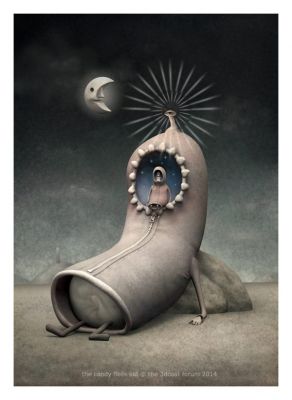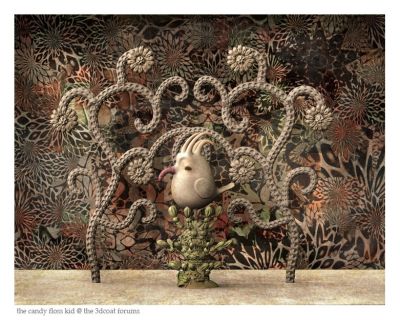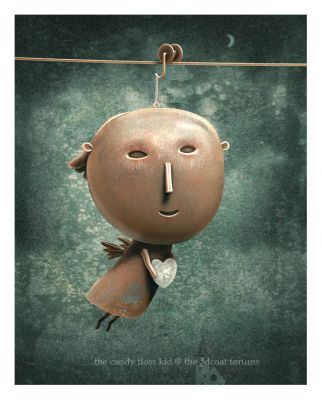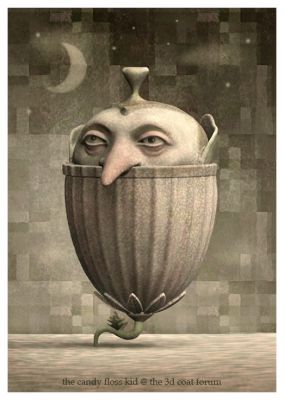-
Posts
698 -
Joined
-
Last visited
Content Type
Forums
Calendar
Gallery
Everything posted by The Candy-floss Kid
-

does 3d coat have the brushes i used in zbrush?
The Candy-floss Kid replied to Flippers's topic in General 3DCoat
With the understanding that ZBrush brushes have become for ZBrush users a consensual conceptual task orientated metaphor for expectant behavior then providing the new user with such a folder of brushes is a good idea at the very least to get them up and running in surface mode sculpting. The only issue with expectant awareness is that at some point it becomes similar to dressing a new romantic partner in your old partner's cloths. The finesse with 3DCoat in Surface mode comes with multiple resolution sculpting. Tweaking brushes to perform in this environment holds the key at which point comparison between applications falls away. Although similar in some ways a different conceptual penny has to drop when using 3DCoat before you start to fly with regard the brushes. After the initial honeymoon the main cross application relationship dilemma is this: when attempting foreplay with Pose you may find yourself hankering for Transpose. Whilst 3DC's Pose is a great utility for Homo caelestis; it isn't quite so for the average Homo sapien particularly with regard to character design . My personal observation as a user of both applications is that the finesse of sculpted work created in both applications is tangible less by 'surface' but more so by curve ,attitude, pose , design/ scale relationships, and sense of weight. -

PBR Some Useage Questions
The Candy-floss Kid replied to The Candy-floss Kid's topic in General 3DCoat
Thank you Javis, I am now diffusely illuminated. -
Hi folks, trying to catch up with all the new exciting changes in 3DCoat and have a few artistic questions regarding PBR materials. ----------------------------------------------------------------------------------------------------------------------------------------------------- 1, PBR materials can be used as a sculpting material for better sculpting feedback in voxel and surface mode? 2, PBR materials can be applied to existing vertex painted objects to affect only surface qualities without affecting existing vertex painted color? 3, Can vertex paint be added over a PBR Material that has a texture driven color map? 4a, Can PBR materials be used as faux lighting techniques by setting different diffuse qualities? 4b, Do PBR materials have an emissive mode?
-

Stating a Character From Scratch: Best Way
The Candy-floss Kid replied to bobzilla's topic in General 3DCoat
An answer from Digman in a recent thread which is very sound advice Thinking of lower resolutions as the basic volume of your virtual clay armature to begin your work is the best way forward. Serge T offered great advice on the principle as there truly is no definitive method. Glad to read that you found a way your comfortable to work with. -

Pose Falloff - Axis Inputs?
The Candy-floss Kid replied to The Candy-floss Kid's topic in General 3DCoat
Thanks. -
the artist in me a, sees a graph and panics. b, looks at all the rainbow colors of the falloff and wonders where the pot of gold is hidden. Explanation - crystal clear. Many thanks
-

Useful angelscript for version 4 ! - links (& v2022)
The Candy-floss Kid replied to Carlosan's topic in Scripting
Cool - thanks Carlosan, thanks ajz3d. -
Carlosan, methinks we needs a single sticky thread to keep all ajz3d's fabulous scripts in one tidy collection?
- 6 replies
-
- render settings
- script
-
(and 1 more)
Tagged with:
-

workflow for painting a zbrush model in 3dcoat.
The Candy-floss Kid replied to zenarc's topic in General 3DCoat
Suggestion would be to export the low rez for unwrapping in 3DCoat or use UVMaster in ZBrush if your needs are less fussy. Import in to the retopo room >uv if required > then merge this to the paint room. Stick to ZBrush for displacement maps - better the devil you know. Keep ZBrush as the working environment for your multi resolution. If you unwrap in 3DC you can just import your uv'ed mesh back into the zbrush subtool to transfer the uv's whilst keeping all your resolution levels. 3DC is the more advanced environment for photoshop like painting control,retopo as well as uv noodling - use it's strengths for color map painting. When you import the map back from 3DC in to ZBrush don't forget to flip vertical on the importing texture before applying. Play each application to it's strength and purpose and you'll save lots of time. -
Your ain't kiddin'. Sadly it not 100% accurate on a basic sphere - more in the ball park.
-
You did it!! Well done. I noticed in his tutorial on beveling using pose falloff that AbnRanger also dragged the line clear of the form using grid snap to avoid the unwanted falloff range. I wonder after your investigation - if you could you tell me the what the x y axis inputs are to better understand fine tuning the pose falloff graph? It would be good to get a better user understanding of the pose tool.
-
Ooh nice. I had no idea merged imports could pick up uv map texture info as well as vertex paint. Klane, A cheap and dirty way is to apply a texture as a projected spherical map by importing a texture as a mask then apply the mask as "spherical" - use this to apply bumps when sculpting. There's also little green dot/ gizmo when in mask mode using this facility that you can right click to better position and adjust the map.
-
Depending on the mesh resolution you may need to apply smooth quite a few times. You can now set smooth to repeat as many times as you think you might need. youtube channel - smoothing
-
Could someone illuminate me on the axis inputs to better understand fine tuning the pose falloff graph?
-
Looking at your issue more it strikes me that there is a vast variation on results depending on the falloff. In other words it doesn't look like the falloff is suiting your needs. In AbnRanger's recent video on the effects possible with pose falloffs to create bevel shapes, the clear indication is that the falloff can drive all kinds of shaping/beveling variations. I suspect - find your falloff and you'll achieve exactly what you want. The permutations available with the pose tool can be a blessing and curse. The pose falloff curve interface needs further contextual hints to what the curve itself represents. These inputs should also be marked clearly on the curve diagram's y and x.
-
Hi Ajz3D, It is kinda fiddly I agree - where you place your rotation point , the blur of the pose falloff etc. Whilst I can get good results, there's often some little issue that creeps in. Often a very slight bulging where you don't want it. I often wonder whether it is the accuracy of the blur. If you apply a pose selection with the rectangle marquee and blur/ soften it - the blur does not distribute accurately / evenly through the cross section of the form. The best results I find are with the lattice deformation - selecting all points , shift clicking and moving the transform tool to the point of rotation at the boundary of the blur. I wonder does raising subdivision at the junction of the bend you need help?
-
From the album: Floss's Bag O' Candy
Rumbustious Love Droids. Making sweet love with 3DCoat and Groboto. -
From the album: Floss's Bag O' Candy
Contemplation within a Parka of infinite perception. Like Russian dolls, there's a fellow inside the hood of the coat, inside the hood of the coat ....... Vertex painting across all visible object layers simultaneously to allow for a more natural color creep. -
-
From the album: Floss's Bag O' Candy
Voxel sculpted , vertex painted. -
From the album: Floss's Bag O' Candy
Voxel sculpted, vertex painted. -
From the album: Floss's Bag O' Candy
Voxel sculpted and vertex painted.







